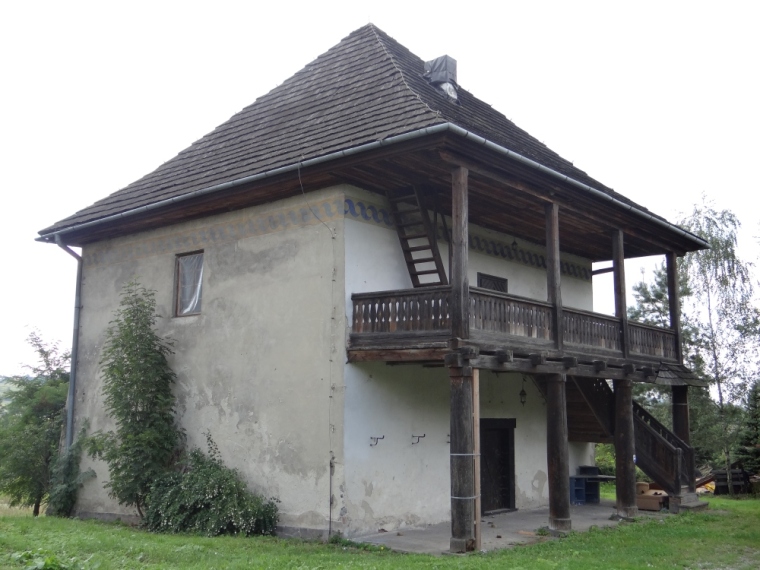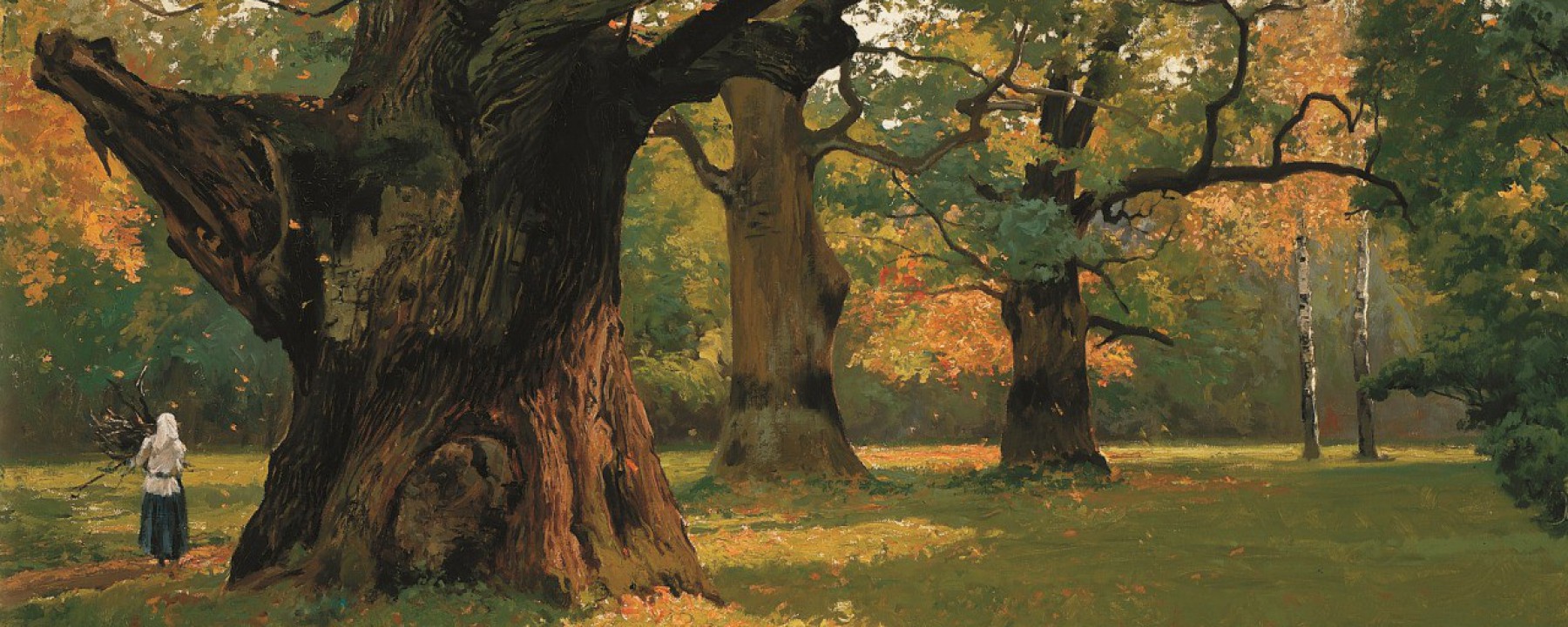In short, the meaning of “lamus dworski” could be traslated as a manorial outbuilding or storage building.
A BIT OF HISTORY
Historically speaking, a lamus dworski was a storage built close to traditional dwory (singular: a dwór – an architectural style typical for rural houses/manors of Polish nobility, that started appearing around the Renaissance era).
It’s hard to trace when exactly did the word “lamus” appear in the Polish language. According to linguists, it was derived from German “Lehmhaus” which means a mud house. However, the Polish lamus building wasn’t made of mud or covered with mud. [as a side note, I saw that the Polish Wikipedia article about lamus is incorrectly linked to a quincha bulding type there, however there’s little to none actual correlation between these two apart from the lamus being (sometimes) made from wood!]
Lamus dworski, called also just a lamus for short, was typically a brick and stone building, later also made entirely from wood, serving as a warehouse or granary.
Following Zygmunt Gloger‘s definition from his famous “Encyklopedia staropolska ilustrowana” (transl. “Old-Polish Encyclopedia, Illustrated”, released in 1900-1903), lamus was commonly called also a “skarbiec” (treasury) and was used for storing old documents, books, armor, weapons, harnesses, crates with valuable materials like copper, iron, lead, and so on. In the Renaissance and Baroque eras it was made of brick and stone, and its windows were typically protected by built-in steel grilles and closed with shutters. In some known cases much older medieval towers would’ve been remodelled into a lamus.
In poorer areas the building was made rather exclusively of wood, a much cheaper and commonly available material to use in the past. In many cases it started appearing also next to some wealthier peasant houses as a granary with storage space for appliances. On the countryside it eventually took a role of a multipurpose storage building with a cold storage space, where things like cold cuts, pantry supplies, processed food, all kinds of tools, saddles, leather products, and many other things were kept.
It can be recognized by some characteristic architectural forms and elements, for example an arcaded porch or wooden balcony and overhanging roof which you can see on many pictures below. Typically, it had a hip roof (Pol. dach czterospadowy) or a Polish mansard roof (Pol. łamany dach polski). There was never one common style for a lamus, and it was appearing in a lot of slightly different regional architectural forms, linked primarily by its function.






CONTEMPORARY USE
These buildings were falling out of fashion slowly over the time, and were a rare reminder of the old times already around the second half of 19th century. According to the words by Zygmunt Gloger, unused upper floors of these buldings were sometimes serving as holiday bedrooms for teens visiting the countryside during summer in 19th century.
Eventually, the word “lamus” became a common slang for old or outdated things.
In the contemporary slang it can even gain a pejorative meaning, for example to describe a person who’s an outcast or a loser (sometimes used e.g. in the online gaming slang).
It’s rarely in use nowadays, but can be still heard to describe a storage room in a house, a type of “rupieciarnia” (lumber-room or junk room).
The word survived also in a few idioms or phrases, for example “odszedł do lamusa” (literally: went into lamus, meaning: is out of use, e.g. in a context of old electric equipment) or “perła z lamusa” (literally: a pearl from a lamus, meaning something similar to the English phrase “a diamond in the rough”).
WHY THE NAME FOR MY BLOG?
When I was setting up my blog, I wanted to find a good name that would reflect not only the process of my research but also the particular nature of things I wanted to describe. Eventually, I thought of the phrases which I quoted in the last paragraph above. After all, majority of the topics I wanted to focus on: the old customs and ancient stories did go into a figurative lamus during our contemporary urbanized and digitalized times. I wanted to dig them out, find the pearls of informations and connect them like dots into a valuable necklace of data, show the intriguing old crates of informations about customs, dig up the old books, collect informations still alive in corners of the minds of the people.
I really hope I managed to do it in this sense, and that my small “lamus dworski” does feel like a valuable storage, as in the original meaning of that word.
contact: lamusdworski [at] gmail [dot] com

Do you plan to write about ancient Polis/ Slavic roots of Polish people and people that lived the area of Poland? About Lechici and slavic history from before 1000 a.d. Thank you
LikeLike
Who is the artist that painted the lovely woods picture you have at the opening of your blog?
LikeLike
Hello Dina! It’s a painting by Michał Gorstkin Wywiórski, you can read a bit more about it here: https://rogalin.mnp.art.pl/en/museum/picture/stare-deby-w-parku-w-rogalinie
LikeLike
In late summer 2018, my wife and I, along with a cousin, traveled for a month across Poland to visit the places of our ancestors. During that trip I took advantage of spare time to make a series of artworks pertaining to many of the historic sites. I did both metalpoint and acrylic works. An article I later submitted to a national “Outdoor Painter Magazine was published. I’d like to share this article with your readers. Ancestral Plein Air Journey
By
Contributing Author; Mick Grochowski ; February 22, 2019
In my youth, Poland, the land of my ancestors, was a mystery to me. It intrigued me that “the elders,” my grandparents and great-grandparents, great-aunts and uncles, spoke the “mysterious” Polish language to each other, but never really shared it with us, the younger generation. We listened, for years, to loud, raucous stories during holidays and parties. We heard solemn whispers during times of crisis. It always seemed that the old country must have been a very magical though traumatic land. Never did I give much thought as to why they would have left all they had, and those they knew, to travel to a new world.
Art has always been an important part of my life. From grade school through high school it was the most enjoyable part of the day. In college, I found it important enough that I would earn a minor degree in fine art. So, recently, upon the sale of a print and graphic business that my wife and I owned, we agreed to take a trip to Poland, the land of our ancestors. Having done quite a bit of ancestry research on both of our families, (coincidentally, her ancestors came from a small town in Poland near that of my family) we decided that during our trip we’d visit the towns they had come from, not just the normal tourist sites most people visit.
As travel plans were coming together, family research was leading to places I had not imagined. It seems that in tracing surnames, I was finding information dating as far back as the Renaissance. There were several bishops, one of whom was secretary to the king. One was a noted poet, who had lost his “parish” because of writings that angered church leaders. We also located the tombstone of a great Polish knight that had been inscribed with the words of that poet in 1587. There was even a saint. While I cannot, technically, claim all of these historical figures as direct ancestors, it is always a possibility.
Somehow, and it may have been in the back of my mind all along, my thoughts came to where this ancestral trip should also become a plein air painting journey. Connecting the ancestral part of the trip to the medieval part of Poland’s history was easy, at least in my mind. So that was it! We’d travel for a month through Poland’s countryside, the land of our ancestors, to learn of and record scenes of our “origin.”
Painting Supplies for the Journey
Those of you involved plein air painting know of the logistic concerns in traveling with supplies and finished works. Based on previous experience (a year before we’d traveled the entire Route 66, plein air painting) and knowing that we were traveling by car, staying in Airbnb’s, agritourism sites, and an occasional old hotel, I was determined to keep my painting stuff to a minimum.
Typically, I switch between oil and acrylic work. So, for this trip I opted for Golden acrylic paints and a palette of titanium white, Payne’s gray, ultramarine and cobalt blue, yellow ochre, cad yellow light, Indian yellow, and alizarin crimson. As supports I opted for Centurion linen canvas, 10 sheet pad, in both 16×20 and 9×12. I wanted to be able to roll the paintings in a tube for the trip back to the States.
Secondly, as I knew we’d be limited for time at most locations, I decided to attempt an alternate plein air technique which would be faster and not require drying time. I’d experimented in the medieval method of silverpoint and metalpoint drawing, so it seemed fitting that I’d attempt to draw medieval subject matter using a medieval method. After a bit more experimenting, I discovered that the Centurion linen worked quite well for metalpoint without additional preparation. So I was all set. I would do 16×20, acrylic on linen, plein air paintings and 9×12 metalpoint drawings. They could then be rolled up for the return trip and mounted on panels to be exhibited.
About the Artist: Michael (Mick) Grochowski is based in Norfolk, Virginia. He is a member of Chesapeake Bay Art Association, Hampton Art League, Tidewater Art Alliance, and Mid-Atlantic Plein Air Painters Association. Website: http://www.MickG-Art.com
LikeLiked by 1 person
Thank you so much for sharing this wonderfully written article. I’m really curious about your work!
LikeLike
Your necklace metaphor fits perfectly. Lamus Dworski, is a piece of history that I would never have heard of, making it a beautiful information pearl, connected to a string of precious ancient and disappearing information pearls, making a necklace of keepsakes and heirlooms from the ancestors (and from you), all kept in a Lamus Dworski storage site for needed and valuable items, while being the namesake of one of those treasures itself. The site name is like an ouroboros, I like it.
Over the years I sometimes pop in and read a page or two and wanted to let you know how much I appreciate your work. Thank you.
LikeLike
Hello Lamus;
Sorry this took so long to reply. However oto jest! the link on pinterest to the series of artwork, metal-point and paintings, all en plein air completed during our trip to Poland https://www.pinterest.com/mickg2468/poland-journey-artwork/
LikeLike
Hi there Mick! Sorry for my late response as well. These are wonderful impressions of the Polish landscape :) Thank you so much for sending the link!
LikeLike